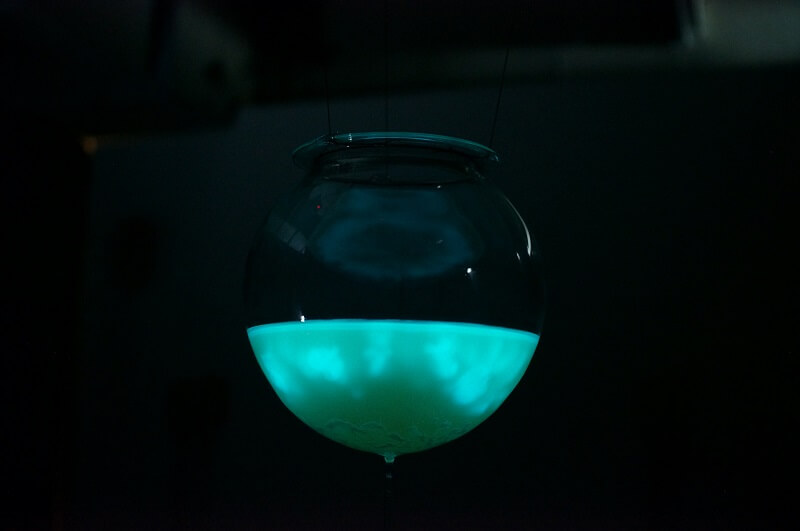WE ARE NOT ALONE

Performances
Description:
Media: Higher-order ambisonics, wavefield synthesis, ultrasonic sound-beam, photobacterium phosphoreum, blown glass.
A sphere stands alone, suspended in the middle of a blacked-out room. When first entering, the eyes take a few moments to become accustomed to the darkness. A wash of 3D sound slowly penetrates the space. Every so often the space is disturbed, and the sphere and the sound field erupt into life, forming vortices of luminescence and living sound.
What first appears as a single volume of beguiling glowing liquid is in fact a vast colony of living organisms; bioluminescent bacteria have been breeding in the sphere. Although we are looking onto them, enclosed in glass, we are ourselves enclosed inside a space of waves and points of sound, behaving as if it too were alive.
The bacteria produce their bioluminescence when agitated. This agitation is created by controlling a flow of air pumped into the glass sphere, stimulating a 3-D show of beguiling patterns. These patterns are then represented by numerical data and sonified to create 3-D sound. The sonic complexity of the spatial sonification required materials to be pre-rendered, and then triggered in sync with the computer-controlled bacterial agitation. The sound materials consist of three layers: a 5th order horizontal ambisonics layer for a 12-14 channel loudspeaker array, a wavefield synthesis layer creating focused sounds inside the listening space, and a channel of sound played over an ultra-sonic loudspeaker, reflecting off the glass sphere, giving the illusion that this sound was originating directly from the bacteria.
A sphere stands alone, suspended in the middle of a blacked-out room. When first entering, the eyes take a few moments to become accustomed to the darkness. A wash of 3D sound slowly penetrates the space. Every so often the space is disturbed, and the sphere and the sound field erupt into life, forming vortices of luminescence and living sound.
What first appears as a single volume of beguiling glowing liquid is in fact a vast colony of living organisms; bioluminescent bacteria have been breeding in the sphere. Although we are looking onto them, enclosed in glass, we are ourselves enclosed inside a space of waves and points of sound, behaving as if it too were alive.
The bacteria produce their bioluminescence when agitated. This agitation is created by controlling a flow of air pumped into the glass sphere, stimulating a 3-D show of beguiling patterns. These patterns are then represented by numerical data and sonified to create 3-D sound. The sonic complexity of the spatial sonification required materials to be pre-rendered, and then triggered in sync with the computer-controlled bacterial agitation. The sound materials consist of three layers: a 5th order horizontal ambisonics layer for a 12-14 channel loudspeaker array, a wavefield synthesis layer creating focused sounds inside the listening space, and a channel of sound played over an ultra-sonic loudspeaker, reflecting off the glass sphere, giving the illusion that this sound was originating directly from the bacteria.
Related Elements:
Technologies
Complex Structures
Authors
Media

